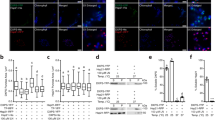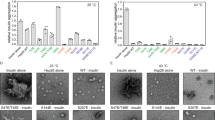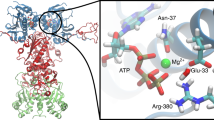Abstract
The principal heat-shock proteins that have chaperone activity (that is, they protect newly made proteins from misfolding) belong to five conserved classes: HSP100, HSP90, HSP70, HSP60 and the small heat-shock proteins (sHSPs). The sHSPs can form large multimeric structures and have a wide range of cellular functions, including endowing cells with thermotolerance in vivo1,2 and being able to act as molecular chaperones in vitro3,4,5,6,7,8; sHSPs do this by forming stable complexes with folding intermediates of their protein substrates9,10. However, there is little information available about these structures or the mechanism by which substrates are protected from thermal denaturation by sHSPs. Here we report the crystal structure of a small heat-shock protein from Methanococcus jannaschii, a hyperthermophilic archaeon. The monomeric folding unit is a composite β-sandwich in which one of the β-strands comes from a neighbouring molecule. Twenty-four monomers form a hollow spherical complex of octahedral symmetry, with eight trigonal and six square ‘windows’. The sphere has an outer diameter of 120 Å and an inner diameter of 65 Å.
This is a preview of subscription content, access via your institution
Access options
Subscribe to this journal
Receive 51 print issues and online access
$199.00 per year
only $3.90 per issue
Buy this article
- Purchase on Springer Link
- Instant access to full article PDF
Prices may be subject to local taxes which are calculated during checkout




Similar content being viewed by others
References
Schirmer, E. C., Lindquist, S. & Vierling, E. An Arabidopsis heat shock protein complements a thermotolerance defect in yeast. Plant Cell 6, 1899–1909 (1994).
van den IJssel, P. R., Overkamp, P., Knauf, U., Gaestel, M. & de Jong, W. W. Alpha A-crystallin confers cellular thermoresistance. FEBS Lett. 355, 54–56 (1994).
Horwitz, J. Alpha-crystallin can function as a molecular chaperone. Proc. Natl Acad. Sci. USA 89, 10449–10453 (1992).
Jacob, U., Gaestel, M., Engel, K. & Buchner, J. Small heat shock proteins are molecular chaperones. J.Biol. Chem. 268, 1517–1520 (1993).
Merck, K. B. et al. Structural and functional similarities of bovine alpha-crystallin and mouse small heat-shock protein. A family of chaperones. J. Biol. Chem. 268, 1046–1052 (1993).
Lee, G. J., Pokala, N. & Vierling, E. Structure and in vitro molecular chaperone activity of cytosolic small heat shock proteins from pea. J. Biol. Chem. 270, 10432–10438 (1995).
Chang, Z. et al. Mycobacterium tuberculosis 16-kDa antigen (Hsp16.3) functions as an oligomeric structure in vitro to suppress thermal aggregation. J. Biol. Chem. 271, 7218–7223 (1996).
Jaenicke, R. & Creighton, T. E. Junior chaperones. Curr. Biol. 3, 234–235 (1993).
Ehrnsperger, M., Graber, S., Gaestel, M. & Buchner, J. Binding of non-native protein to Hsp25 during heat shock creates a reservoir of folding intermediates for reactivation. EMBO J. 16, 221–229 (1997).
Lee, G. J., Roseman, A. M., Saibil, H. R. & Vierling, E. Asmall heat shock protein stably binds heat-denatured model substrates and can maintain a substrate in a folding-competent state. EMBO J. 16, 659–671 (1997).
Kim, K. K., Yokota, H., Kim, S.-H. Purification, crystallization and preliminary X-ray crystallographic analysis of small heat shock protein homolog from Methanococcus jannaschii. J. Struct. Biol. 121, 76–80 (1998).
Tseng, T. S. et al. Two rice (Oryza sativa) full-length cDNA clones encoding low-molecular-weight heat-shock proteins. Plant Mol. Biol. 18, 963–965 (1992).
Kim, R., Kim, K. K., Yokota, H. & Kim, S.-H. Small heat shock protein of Methanococcus jannaschii, a hyperthermophile. Proc. Natl Acad. Sci. USA(in press).
Braig, K. et al. The crystal structure of the bacterial chaperonin GroEL at 2.8 Å. Nature 371, 578–586 (1994).
Leroux, M., Melki, R., Gordon, B., Batelier, G. & Candido, E. P. M. Structure–function studies on small heat shock protein oligometric assembly and interaction with unfolded polypeptides. J. Biol. Chem. 272, 24646–24656 (1997).
Hunt, J. F., Weaver, A. J., Landry, S. J., Gierasch, L. & Deisenhofer, J. The crystal structure of the GroES co-chaperonin at 2.8 Å resolution. Nature 379, 37–45 (1996).
Caspers, G.-J., Leunissen, J. A. M. & de Jong, W. W. The expanding small heat-shock protein family, and structural predictions of the conserved “α-crystallin domain”. Mol. Evol. 40, 238–248 (1995).
Yeh, C. H. et al. Expression of a gene encoding a 16.9-kDa heat-shock protein, Oshsp16.9, in Escherichia coli enhances thermotolerance. Proc. Natl Acad. Sci. USA 94, 10967–10972 (1997).
Plater, M. L., Goode, D. & Crabbe, M. J. C. Effects of site-directed mutations on the chaperone-like activity of αB-crystallin. J. Biol. Chem. 271, 28558–28566 (1996).
Merck, K. B. et al. Comparison of the homologous carboxy-terminal domain and tail of alpha-crystallin and small heat shock protein. Mol. Biol. Rep. 18, 209–215 (1993).
Leroux, M., Ma, B. J., Batelier, G., Melki, R. & Candido, E. P. M. Unique structural features of a novel class of small heat shock proteins. J. Biol. Chem. 272, 12847–12853 (1997).
Otwinowski, Z. in Data Collection and Processing (eds Sawyer, L., Isaacs, N. & Bailey, S.) 56–62 (SERC Daresbury Laboratory, Warrington, UK, (1993)).
Cowtain, K. D. & Main, P. Improvement of macromolecular electron-density maps by the simultaneous application of real and reciprocal space constraints. Acta Crystallogr. D 49, 148–157, (1993).
Jones, T. A., Zou, J.-Y., Cowan, S. W. & Kjeldgaard, M. Improved methods for binding protein models in electron density maps and the location of errors in these models. Acta Crystallogr. A 47, 110–119 (1991).
Brünger, A. T. X-PLOR version 3.1 (Yale Univ. Press, New Haven, CT, (1993)).
Laskowski, R. A., MacArthur, M. W., Moss, D. S. & Thronton, J. M. J. Appl. Crystallogr. 26, 283–291 (1993).
Genetics Computer Group Program manual for the GCG package, version (GCG, Madison, WI, (1991)).
Acknowledgements
We thank D. King for doing the electrospray mass spectrometry; H. Yokota for help with protein preparation, D. Boisvert for critical discussion of the manuscript, and R. Sweet at the NSLS for data collection. This work was funded by the US Department of Energy (R.K. and S.-H.K.).
Author information
Authors and Affiliations
Corresponding author
Rights and permissions
About this article
Cite this article
Kim, K., Kim, R. & Kim, SH. Crystal structure of a small heat-shock protein. Nature 394, 595–599 (1998). https://doi.org/10.1038/29106
Received:
Accepted:
Issue Date:
DOI: https://doi.org/10.1038/29106
This article is cited by
-
Mechanical activation and expression of HSP27 in epithelial ovarian cancer
Scientific Reports (2024)
-
Tardigrade small heat shock proteins can limit desiccation-induced protein aggregation
Communications Biology (2023)
-
A chromosome-level genome of Semiothisa cinerearia provides insights into its genome evolution and control
BMC Genomics (2022)
-
Knockdown of heat shock transcription factor 1 decreases temperature stress tolerance in Bemisia tabaci MED
Scientific Reports (2022)
-
Emerging prospects of protein/peptide-based nanoassemblies for drug delivery and vaccine development
Nano Research (2022)
Comments
By submitting a comment you agree to abide by our Terms and Community Guidelines. If you find something abusive or that does not comply with our terms or guidelines please flag it as inappropriate.



